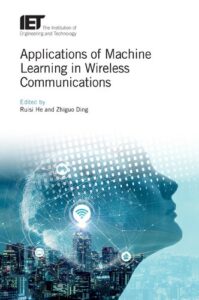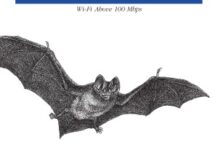| Book Name: | Applications of Machine Learning in Wireless Communications |
| Category: | Communication Books |
| Language: | English |
| Format: | |
| Free Download: | Available |
Applications of Machine Learning in Wireless Communications Edited by Ruisi He and Zhiguo Ding | PDF Free Download.
| Book Details : | |
|---|---|
| Language | English |
| Pages | 492 |
| Format | |
| Size | 25.4 MB |
Applications of Machine Learning in Wireless Communications

Machine Learning in Wireless Communications Contents
- Introduction of machine learning
- Machine-learning-enabled channel modeling
- Channel prediction based on machine-learning algorithms
- Machine-learning-based channel estimation
- Signal identification in cognitive radios using machine learning
- Compressive sensing for wireless sensor networks
- Reinforcement learning-based channel sharing in wireless vehicular networks
- Machine-learning-based perceptual video coding in wireless multimedia communications
- Machine-learning-based saliency detection and its video decoding application in wireless multimedia communications
- Deep learning for indoor localization based on bimodal CSI data
- Reinforcement-learning-based wireless resource allocation
- Q-learning-based power control in small-cell networks
- Data-driven vehicular mobility modeling and prediction
Foreword to Applications of Machine Learning in Wireless Communications
The technologies of wireless communications have been changed drastically in recent years. The rapidly growing wave of wireless data is pushing against the boundary of the wireless communication system’s performance.
Such pervasive and exponentially increasing data present imminent challenges to all aspects of the wireless communication system’s design, and the future wireless communications will require robust intelligent algorithms for different services in different scenarios.
Contributions are needed from multidisciplinary fields to enhance the wireless systems, such as computer science, mathematics, control, and many other scientific disciplines.
The combined efforts from scientists from different disciplines are important for the success of the wireless communication industry.
In such an era of big data where data mining and data analysis technologies are effective approaches for wireless system evaluation and design, the applications of machine learning in wireless communications have received a lot of attention recently.
Machine learning provides feasible and new solutions for the complex wireless communication system design.
It has been a powerful tool and popular research topic with many potential applications to enhance wireless communications, e.g. radio channel modeling, channel estimation, signal detection, network management, performance improvement, access control, and resource allocation.
However, most of the current research are separated into different fields and has not been well organized and presented yet.
Therefore, it is difficult for academic and industrial groups to see the potential of using machine learning in wireless communications. It is now appropriate to present detailed guidance on how to combine the disciplines of wireless communications and machine learning.
In this book, present and future developments and trends of wireless communication technologies are depicted based on contributions from machine learning and other fields in artificial intelligence.
The prime focus of this book is given in the physical layer and network layer with a special emphasis on machine-learning projects that are (or are close to) achieving improvements in wireless communications.
A wide variety of research results are merged together to make this book useful for students and researchers. There are 13 chapters in this book, and we have organized them as follows:
Chapter 1 presents an overview of machine-learning algorithms and their applications to provide advice and references to fundamental concepts accessible to the broad community of wireless communication practitioners.
Specifically, the materials are organized into three sections following the three main branches of machine learning: supervised, unsupervised, and reinforcement learning (RL).
Each section starts with an overview to illustrate the major concerns and ideas of this branch. Then, classic algorithms and their last developments are reviewed with typical applications and useful references.
Furthermore, pseudocodes are added to provide interpretations and details of algorithms. Each section ends with a summary in which the structure of this section is untangled and relevant applications in wireless communication are given.
In Chapter2, using machine learning in wireless channel modeling is presented. First of all, the background of machine-learning-enabled channel modeling is introduced.
Then, four related aspects are presented: (i) propagation scenario classification, (ii) machine-learning-based multipath component (MPC) clustering, (iii) automatic MPC tracking, and (iv) deep-learning-based channel modeling.
The results in this chapter can provide references to another real-world measurement data-based channel modeling.
In Chapter 3, the wireless channel prediction is addressed, which is a key issue for wireless communication network planning and operation.
Instead of the classic model-based methods, a survey of recent advances in machine-learning technique-based channel prediction algorithms is provided, including both batch and online methods. Experimental results are provided using real data.
In Chapter 4, new types of channel estimators based on machine learning are introduced, which are different from traditional pilot-aided channel estimators such as least squares and linear minimum mean square errors.
Specifically, two newly designed channel estimators based on deep learning and one blind estimator based on the expectation-maximization algorithms are provided for wireless communication systems.
The challenges and open problems for channel estimation aided by machine-learning theories are also suggested.
In Chapter 5, cognitive radio is introduced as a promising paradigm to solve the spectrum scarcity and to improve the energy efficiency of the next-generation mobile communication network. In the context of cognitive radios, the necessity of using signal identification techniques is first presented.
A survey of signal identification techniques and recent advances in this field using machine learning is then provided. Finally, open problems and possible future directions for cognitive radio are briefly discussed.
Chapter 6 introduces the fundamental concepts that are important in the study of compressive sensing (CS).
Three conditions are described, i.e. the null space property, the restricted isometry property, and mutual coherence, that are used to evaluate the quality of sensing matrices and demonstrate the reconstruction’s feasibility.
Some widely used numerical algorithms for sparse recovery are briefly reviewed, which are classified into two categories, i.e. convex optimization algorithms and greedy algorithms. Various examples are illustrated where the CS principle has been applied to WSNs.
In Chapter 7, the enhancement of the proposed IEEE 802.11p Medium Access Control (MAC) layer is studied for vehicular use by applying RL.
The purpose of this adaptive channel access control technique is to enable more reliable, high throughput data exchanges among moving vehicles for cooperative awareness purposes. Some technical background for vehicular networks is presented, as well as some relevant existing solutions tackling similar channel sharing problems.
Finally, some new findings from combining the IEEE 802.11p MAC with RL-based adaptation and insight into the various challenges appearing when applying such mechanisms in a wireless vehicular network are presented.
Chapter 8 presents the advantage of applying machine-learning-based perceptual coding strategies in relieving bandwidth limitation for wireless multimedia communications.
Typical video coding standards, especially the state-of-the-art high-efficiency video coding (HEVC) standard, as well as recent research progress on perceptual video coding, are included.
An example that minimizes the overall perceptual distortion is further demonstrated by modeling subjective quality with machine-learning-based saliency detection.
Several promising directions in learning-based perceptual video coding are presented to enhance wireless multimedia communication experience.
In Chapter 9, it is argued that the state-of-the-art HEVC standard can be used for saliency detection to generate useful features in the compressed domain.
Therefore, this chapter proposes to learn the video saliency model, with regard to HEVC features. First, an eye-tracking database is established for video saliency detection.
Through the statistical analysis on our eye-tracking database, we find out that human fixations tend to fall into the regions with large-valued HEVC features on splitting depth, bit allocation, and motion vector (MV).
In addition, three observations are obtained with further analysis of our eye-tracking database. Accordingly, several features in the HEVC domain are proposed on the basis of splitting depth, bit allocation, and MV.
Next, a kind of support vector machine is learned to integrate those HEVC features together, for video saliency detection.
Since almost all video data are stored in the compressed form, the proposed method is able to avoid both the computational cost of decoding and the storage cost on raw data.
More importantly, experimental results show that the proposed method is superior to other state-of-the-art saliency detection methods in the compressed or uncompressed domain.
In Chapter 10, deep learning is incorporated for indoor localization based on channel state information (CSI) with commodity 5GHz Wi-Fi. The state-of-the-art deep-learning techniques are first introduced, including deep autoencoder networks, convolutional neural networks, and recurrent neural networks.
The CSI preliminaries and three hypotheses are further introduced and validated with experiments. Then a deep-learning-based algorithm is presented to leverage bimodal CSI data, i.e. average amplitudes and estimated angle of arrivals, in both offline and online stages of fingerprinting.
The proposed scheme is validated with extensive experiments. Finally, several open research problems for indoor localization based on deep-learning techniques are examined.
In Chapter 11, the reinforcement-learning-based wireless resource allocation is presented. First, the basic principle of stochastic approximation is introduced, which is the basis of the RL.
Then how to formulate the wireless resource allocation problems via three forms of Markov decision process (MDP) is demonstrated, respectively, namely finite-horizon MDP, infinite-horizon MDP with discount cost, and infinite-horizon MDP with the average cost.
One of the key knowledge to solve the MDP problem is the system state transition probability, which might be unknown in practice.
Hence, finally, it is shown that when some system statistics are unknown, the MDP problems can still be solved via the method of RL.
In Chapter 12, by integrating information theory with the principle of effective capacity, and energy efficiency optimization problem is formulated with statistical QoS guarantee in the uplink of two-tier small cell networks.
To solve the problem, a Q-learning mechanism based on Stackelberg game framework is introduced, in which a macro-user acts as a leader, and knows all small-cell-users’ transmit power strategies, while the small-cell-users are followers and only communicate with the microcell base station, not with other small-cell base stations.
In a formulated Stackelberg game procedure, the macro-user selects the transmit power level based on the best responses of the small-cell-users.
Then those small-cell-users find their best responses. And in order to improve the self-organizing ability of femtocell, based on the non-cooperative game framework, a Boltzmann distribution-based weighted filter Q-learning algorithm (BDB-WFQA) based on Boltzmann distribution is proposed to realize power allocation.
The simulation results show the proposed distributed Q-learning algorithm has a better performance in terms of convergence speed while providing delay QoS provisioning. The proposed BDB-WFQA algorithm increases the achievable effective capacity of macro-users and better performance compared with another power-control algorithm.
In Chapter 13, the open Jackson queuing network models are used to model the macroscopic level vehicular mobility.
The proposed simple model can accurately describe the vehicular mobility and then further predict various measures of network-level performance like the vehicular distribution, and vehicular-level performance like average sojourn time in each area and the number of sojourned areas in the vehicular networks.
Model validation based on two large-scale urban city vehicular motion traces reveals that such a simple model can accurately predict a number of system metrics interested by the vehicular network performance.
Moreover, two applications are proposed to illustrate that the proposed model is effective in analyzing system-level performance and dimensioning for vehicular networks.
This book aims to help communications system designers gain an overview of the pertinent applications of machine learning in wireless communications, and for researchers to assess where the most pressing needs for further work lie.
This book can also be used as a textbook for the courses dedicated to machine learning-enabled wireless communications.
With contributions from an international panel of leading researchers, this book will find a place on the bookshelves of academic and industrial researchers and advanced students working in wireless communications and machine learning.
We hope that the above contributions will form an interesting and useful compendium on applications of machine learning in wireless communications.
Download Applications of Machine Learning in Wireless Communications (Telecommunications) PDF
Author(s): Ruisi He (editor), Zhiguo Ding (editor)
Series: Telecommunications (Book 81)
Publisher: The Institution of Engineering and Technology, Year: 2019
ISBN: 1785616579,9781785616570
Download Applications of Machine Learning in Wireless Communications in PDF Format For Free.
Related More Books
See More POST On : Communication Books









![[PDF] Draw Buildings and Cities in 15 Minutes Draw Buildings and Cities in 15 Minutes pdf](https://www.freepdfbook.com/wp-content/uploads/2021/06/Draw-Buildings-and-Cities-in-15-Minutes-218x150.jpg)








![[PDF] Digital Image Processing An Algorithmic Introduction Using Java Digital Image Processing An Algorithmic Introduction Using Java](https://www.freepdfbook.com/wp-content/uploads/2022/06/Digital-Image-Processing-An-Algorithmic-Introduction-Using-Java.jpg)




![[PDF] 43 Years JEE ADVANCED + JEE MAIN Chapterwise & Topicwise Solved Papers 43 Years JEE ADVANCED (1978-2020) + JEE MAIN Chapterwise & Topicwise Solved Papers Physics PDF](https://www.freepdfbook.com/wp-content/uploads/2022/03/43-Years-JEE-ADVANCED-1978-2020.jpg)

![[PDF] Problems in Physical Chemistry for JEE (Main & Advanced) Problems in Physical Chemistry for JEE (Main & Advanced) Free PDF Book Download](https://www.freepdfbook.com/wp-content/uploads/2022/03/Problems-in-Physical-Chemistry-for-JEE-Main-Advanced.jpg)
![[PDF] Engineering Physics (McGraw Hill)](https://www.freepdfbook.com/wp-content/uploads/2021/05/bafc8c2685bb6823a9c56134f7fba5df.jpeg)

![[PDF] Engineering Chemistry By Shashi Chawla](https://www.freepdfbook.com/wp-content/uploads/2022/05/Theory-And-Practicals-of-Engineering-Chemistry-By-Shashi-Chawla-free-pdf-book.jpeg)
![[PDF] Chemistry: An Introduction to Organic, Inorganic & Physical Chemistry Chemistry: An Introduction to Organic, Inorganic & Physical Chemistry](https://www.freepdfbook.com/wp-content/uploads/2022/04/Chemistry-An-Introduction-to-Organic-Inorganic-Physical-Chemistry.jpg)
![[PDF] Essentials of Physical Chemistry Essentials of Physical Chemistry Free PDF Book by Bahl](https://www.freepdfbook.com/wp-content/uploads/2022/04/Essentials-of-Physical-Chemistry-bahl.jpg)
![[PDF] Biological control of plant-parasitic nematodes: soil ecosystem management in sustainable agriculture Biological control of plant-parasitic nematodes: soil ecosystem management in sustainable agriculture](https://www.freepdfbook.com/wp-content/uploads/2022/05/Biological-control-of-plant-parasitic-nematodes-soil-ecosystem-management-in-sustainable-agriculture.jpg)
![[PDF] Human Anatomy: Color Atlas and Textbook Human Anatomy: Color Atlas and Textbook Free PDF Book](https://www.freepdfbook.com/wp-content/uploads/2022/05/Human-Anatomy-Color-Atlas-and-Textbook.jpg)
![[PDF] Concepts of Biology Book [Free Download]](https://www.freepdfbook.com/wp-content/uploads/2022/05/Concepts-of-Biology.jpg)
![[PDF] Essentials of Biology [Free Download] Essentials of Biology Free PDF BOok Download](https://www.freepdfbook.com/wp-content/uploads/2022/05/Essentials-of-Biology-Free-PDF-Book-Downlaod.jpg)
![[PDF] Human Biology Book [Free Download]](https://www.freepdfbook.com/wp-content/uploads/2022/05/PDF-Human-Biology-Book-Free-Download.jpg)


